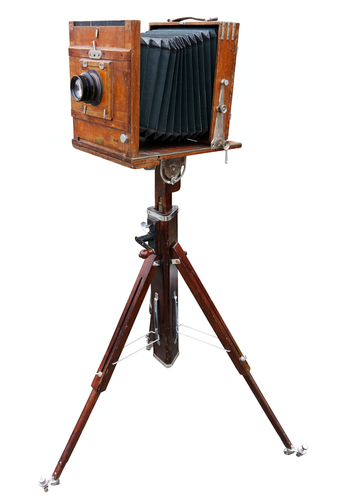Information texts can be presented in many different ways and might include paragraphs, tables, charts, timelines etc. This activity describes the development of photography in the 19th and 20th centuries.

You will be asked questions about the content of the text and the way it is presented. Remember that you can look back at the timeline as often as you want to by clicking the Help button.
The development of photography
|
• 5th - 4th Centuries B.C. |
|
|
|
Chinese and Greek philosophers describe the basic principles of optics and the camera. |
|
• 11th Century A.D. |
|
|
|
The first scientific descriptions of the camera obscura are made by the Iranian scientist Alhazen, but his work is never translated. |
|
• 1664 - 1666 |
|
|
|
Isaac Newton discovers that white light is composed of different colours. |
|
• 1727 |
|
|
|
Johann Heinrich Schulze discovers that silver nitrate darkens upon exposure to light. |
|
• 1794 |
|
|
|
The first Panorama opens, the forerunner of the cinema. |
|
• 1814 |
|
|
|
Joseph Nicephore Niepce achieves the first photographic image with a camera obscura - however, the image requires eight hours of light exposure and the image fades. |
|
• 1837 |
|
|
|
Daguerre produces the first daguerreotype - the first fixed image that does not fade and needs under thirty minutes of light exposure. |
|
• 1840 |
|
|
|
The first American patent in photography is issued to Alexander Wolcott for his camera. |
|
• 1841 |
|
|
|
William Henry Talbot patents the Calotype process - the first negative-positive process making possible the first multiple copies. |
|
• 1843 |
|
|
|
The first advertisement with a photograph is produced in Philadelphia. |
|
• 1851 |
|
|
|
Frederick Scott Archer invents the Collodion process - the images require only two or three seconds of light exposure. |
|
• 1859 |
|
|
|
The panoramic camera is patented - the Sutton. |
|
• 1861 |
|
|
|
Oliver Wendell Holmes invents the stereoscope viewer. |
|
• 1865 |
|
|
|
Photographs and photographic negatives are added to protected works under copyright. |
|
• 1871 |
|
|
|
Richard Leach Maddox invents the gelatin dry plate silver bromide process - negatives no longer need to be developed immediately. |
|
• 1880 |
|
|
|
The Eastman Dry Plate Company is founded. |
|
• 1884 |
|
|
|
George Eastman invents flexible, paper-based photographic film. |
|
• 1888 |
|
|
|
Eastman patents the Kodak roll-film camera. |
|
• 1898 |
|
|
|
Reverend Hannibal Goodwin patents celluloid photographic film. |
|
• 1900 |
|
|
|
The first mass-marketed camera, the Brownie, is produced. |
|
• 1913/1914 |
|
|
|
The first 35 mm still camera is developed. |
|
• 1927 |
|
|
|
General Electric invents the modern flash bulb. |
|
• 1932 |
|
|
|
The first light meter with photoelectric cell is introduced. |
|
• 1935 |
|
|
|
Eastman Kodak markets Kodachrome film. |
|
• 1941 |
|
|
|
Eastman Kodak introduces Kodacolor negative film. |
|
• 1942 |
|
|
|
Chester Carlson receives a patent for electric photography (xerography). |
|
• 1948 |
|
|
|
Edwin Land markets the Polaroid camera. |
|
• 1954 |
|
|
|
Eastman Kodak introduces high speed Tri-X film. |
|
• 1960 |
|
|
|
EG&G develops an extreme depth underwater camera for the U.S. Navy. |
|
• 1963 |
|
|
|
Polaroid introduces instant colour film. |
|
• 1968 |
|
|
|
A photograph of the Earth is taken from the moon. |
|
• 1973 |
|
|
|
Polaroid introduces one-step instant photography with the SX-70 camera. |
|
• 1977 |
|
|
|
George Eastman and Edwin Land are inducted into the National Inventors Hall of Fame. |
|
• 1978 |
|
|
|
Konica introduces the first point-and-shoot, autofocus camera. |
|
• 1980 |
|
|
|
Sony demonstrates the first consumer camcorder. |
|
• 1984 |
|
|
|
Canon demonstrates the first digital electronic still camera. |
|
• 1985 |
|
|
|
Pixar introduces a digital imaging processor. |
|
• 1990 |
|
|
|
Eastman Kodak announces Photo CD as a digital image storage medium. |

